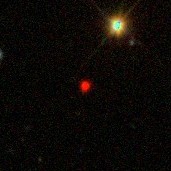TVLM 513-46546
| Observation data Epoch J2000 Equinox J2000 | |
|---|---|
| Constellation | Boötes |
| Right ascension | 15h 01m 08.18646s[1] |
| Declination | +22° 50′ 02.1379″[1] |
| Apparent magnitude (V) | 15.09[2] |
| Characteristics | |
| Spectral type | M9[3] |
| Astrometry | |
| Proper motion (μ) | RA: −43.120±0.111 mas/yr[1] Dec.: −65.138±0.140 mas/yr[1] |
| Parallax (π) | 93.1655 ± 0.1355 mas[1] |
| Distance | 35.01 ± 0.05 ly (10.73 ± 0.02 pc) |
| Details | |
| Mass | 0.09 M☉ |
| Radius | 0.11 R☉ |
| Luminosity | 0.00042 L☉ |
| Temperature | 2,500 K |
| Age | >1 billion years |
| Other designations | |
| Database references | |
| SIMBAD | data |

TVLM 513-46546 is an M9 ultracool dwarf at the red dwarf/brown dwarf mass boundary in the constellation Boötes. It exhibits flare star activity, which is most pronounced at radio wavelengths. The star has a mass approximately 80 times the mass of Jupiter (or 8 percent of the Sun's mass). The radio emission is broadband and highly circularly polarized, similar to planetary auroral radio emissions.[5] The radio emission is periodic, with bursts emitted every 7054 s, with nearly one hundredth of a second precision. Subtle variations in the radio pulses could suggest that the ultracool dwarf rotates faster at the equator than the poles (differential rotation) in a manner similar to the Sun.[6]
Planetary system[edit]
On 4 August 2020 astronomers announced the discovery of a Saturn-like planet TVLM 513b around this star with a period of 221±5 days, a mass of between 0.35 and 0.42 MJ, a circular orbit (e≃0), a semi-major axis of between 0.28 and 0.31 AU and an inclination angle of 71−88°. The companion was detected by the radio astrometry method.[3]
| Companion (in order from star) |
Mass | Semimajor axis (AU) |
Orbital period (days) |
Eccentricity | Inclination | Radius |
|---|---|---|---|---|---|---|
| b | 0.35−0.42 MJ | 0.28−0.31 | 221±5 | 0 | 71−88° | — |
References[edit]
- ^ a b c d Vallenari, A.; et al. (Gaia collaboration) (2023). "Gaia Data Release 3. Summary of the content and survey properties". Astronomy and Astrophysics. 674: A1. arXiv:2208.00211. Bibcode:2023A&A...674A...1G. doi:10.1051/0004-6361/202243940. S2CID 244398875. Gaia DR3 record for this source at VizieR.
- ^ "TVLM 513-46". SIMBAD. Centre de données astronomiques de Strasbourg. Retrieved 2020-08-22.
- ^ a b Curiel, Salvador; Ortiz-León, Gisela N.; Mioduszewski, Amy J.; Torres, Rosa M. (2020). "An Astrometric Planetary Companion Candidate to the M9 Dwarf TVLM 513–46546". The Astronomical Journal. 160 (3): 97. arXiv:2008.01595. Bibcode:2020AJ....160...97C. doi:10.3847/1538-3881/ab9e6e. S2CID 220961489.
- ^ Harding, L. K.; Hallinan, G.; Boyle, R. P.; Golden, A.; Singh, Navtej; Sheehan, B.; Zavala, R. T.; Butler, R. F. (December 2013). "Periodic Optical Variability of Radio-detected Ultracool Dwarfs". The Astrophysical Journal. 779 (2): 101. arXiv:1310.1367. Bibcode:2013ApJ...779..101H. doi:10.1088/0004-637X/779/2/101. S2CID 41734103. Retrieved 3 November 2022.
- ^ Hallinan, G. (2006). "Rotational Modulation of the Radio Emission from the M9 Dwarf TVLM 513-46546: Broadband Coherent Emission at the Substellar Boundary?". The Astrophysical Journal. 653 (1): 690–699. arXiv:astro-ph/0608556. Bibcode:2006ApJ...653..690H. doi:10.1086/508678. S2CID 118885768.
- ^ Wolszczan, A.; Route, M. (2014). "Timing Analysis of the Periodic Radio and Optical Brightness Variations of the Ultracool Dwarf, TVLM 513-46546". The Astrophysical Journal. 788 (1): 23. arXiv:1404.4682. Bibcode:2014ApJ...788...23W. doi:10.1088/0004-637X/788/1/23. S2CID 119114679.

